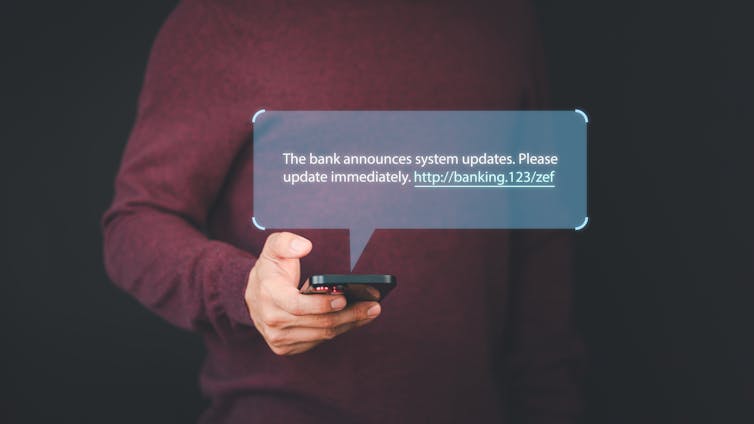Wed 23 October 2024:
Despite huge advances in cyber security, one weakness continues to overshadow all others: human error.
Research has consistently shown human error is responsible for an overwhelming majority of successful cyber attacks. A recent report puts the figure at 68%.
No matter how advanced our technological defences become, the human element is likely to remain the weakest link in the cyber security chain. This weakness affects everyone using digital devices, yet traditional cyber education and awareness programs – and even new, forward-looking laws – fail to adequately address it.
So, how can we deal with human-centric cyber security related challenges?
Understanding human error
There are two types of human error in the context of cyber security.
The first is skills-based errors. These occur when people are doing routine things – especially when their attention is diverted.
For example, you might forget to back up desktop data from your computer. You know you should do it and know how to do it (because you have done it before). But because you need to get home early, forgot when you did it last or had lots of emails to respond to, you don’t. This may make you more exposed to a hacker’s demands in the event of a cyber attack, as there are no alternatives to retrieve the original data.
The second type is knowledge-based errors. These occur when someone with less experience makes cyber security mistakes because they lack important knowledge or don’t follow specific rules.
For example, you might click on a link in an email from an unknown contact, even if you don’t know what will happen. This could lead to you being hacked and losing your money and data, as the link might contain dangerous malware.

Many cyber attacks are successful because people click on unknown links in emails and text messages. ParinPix/Shutterstock
Traditional approaches fall short
Organisations and governments have invested heavily in cyber security education programs to address human error. However, these programs have had mixed results at best.
This is partly because many programs take a technology-centric, one-size-fits-all approach. They often focus on specific technical aspects, such as improving password hygiene or implementing multi-factor authentication. Yet, they don’t address the underlying psychological and behavioural issues that influence people’s actions.
The reality is that changing human behaviour is far more complex than simply providing information or mandating certain practices. This is especially true in the context of cyber security.
Public health campaigns such as the “Slip, Slop, Slap” sun safety initiative in Australia and New Zealand illustrate what works.
Since this campaign started four decades ago, melanoma cases in both countries have fallen significantly. Behavioural change requires ongoing investment into promoting awareness.
The same principle applies to cyber security education. Just because people know best practices doesn’t mean they will consistently apply them – especially when faced with competing priorities or time pressures.
New laws fall short
The Australian government’s proposed cyber security law focuses on several key areas, including:
- combating ransomware attacks
- enhancing information sharing between businesses and government agencies
- strengthening data protection in critical infrastructure sectors, such as energy, transport and communications
- expanding investigative powers for cyber incidents
- introducing minimum security standards for smart devices.

Earlier this month the minister for cyber security Tony Burke introduced new cyber security laws. Mick Tsikas/AAP
These measures are crucial. However, like traditional cyber security education programs, they primarily address technical and procedural aspects of cyber security.
The United States is taking a different approach. Its Federal Cybersecurity Research and Development Strategic Plan includes “human-centred cybersecurity” as its first and most important priority.
The plan says
A greater emphasis is needed on human-centered approaches to cybersecurity where people’s needs, motivations, behaviours, and abilities are at the forefront of determining the design, operation, and security of information technology systems.
3 rules for human-centric cyber security
So, how can we adequately address the issue of human error in cyber security? Here are three key strategies based on the latest research.
- Minimise cognitive load. Cyber security practices should be designed to be as intuitive and effortless as possible. Training programs should focus on simplifying complex concepts and integrating security practices seamlessly into daily workflows.
- Foster a positive cyber security attitude. Instead of relying on fear tactics, education should emphasise the positive outcomes of good cyber security practices. This approach can help motivate people to improve their cyber security behaviours.
- Adopt a long-term perspective. Changing attitudes and behaviours is not a single event but a continuous process. Cyber security education should be ongoing, with regular updates to address evolving threats.
__________________________________________________________________________

https://whatsapp.com/channel/0029VaAtNxX8fewmiFmN7N22
__________________________________________________________________________
Ultimately, creating a truly secure digital environment requires a holistic approach. It needs to combine robust technology, sound policies, and, most importantly, ensuring people are well-educated and security conscious.
If we can better understand what’s behind human error, we can design more effective training programs and security practices that work with, rather than against, human nature.
Author:
![]()
Jongkil Jay Jeong
Senior Research Fellow, Deakin Cyber Research & Innovation Centre, Deakin University
This article is republished from The Conversation under a Creative Commons license. Read the original article.
______________________________________________________________
FOLLOW INDEPENDENT PRESS:
WhatsApp CHANNEL
https://whatsapp.com/channel/0029VaAtNxX8fewmiFmN7N22
![]()
TWITTER (CLICK HERE)
https://twitter.com/IpIndependent
FACEBOOK (CLICK HERE)
https://web.facebook.com/ipindependent
YOUTUBE (CLICK HERE)
https://www.youtube.com/@ipindependent
Think your friends would be interested? Share this story!





